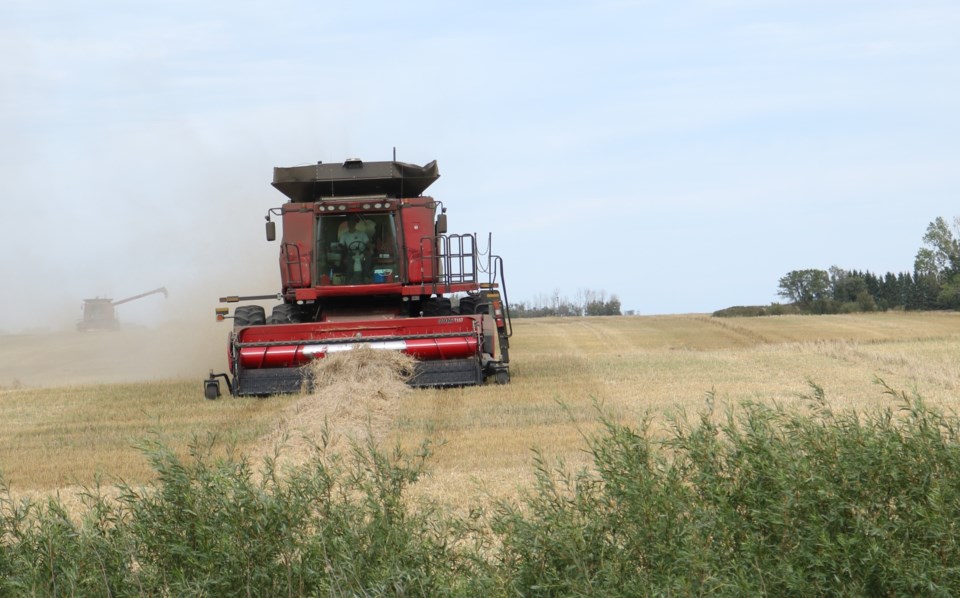Little to no precipitation was received this past week allowing producers another week of good conditions to help wrap up the 2021 harvest.
Producers in the southern regions are mostly finished their harvest and have shifted their focus to other fall field work.
There are challenges with harvesting crops like canola and flax due to regrowth across all regions of the province.
Ninety-five per cent of the crop has been combined, which is up from 89 per cent last week, and remains well ahead of the five-year (2016-2020) average for this time of year of 70 per cent.
An additional three per cent of the crop is swathed or ready to straight-cut.
East-Central Saskatchewan:
· Crop District 5 – Melville, Yorkton, Cupar, Kamsack, Foam Lake, Preeceville and Kelvington areas
· Crop District 6A – Lumsden, Craik, Watrous and Clavet areas
Ninety-four per cent of the crop is now combined, up from 84 per cent last week and remaining well ahead of the five-year (2016-2020) average of 62 per cent. An additional 14 per cent of the crop is swathed or ready to straight-cut.
Producers are noting that regrowth in flax and canola has become an issue and is preventing straight cutting until it can be dried down.
No precipitation was reported for the region this week. Soil moisture is very low resulting in very little fall field work being done. There are several reports of fall seeded cereals not germinating due to the overly dry conditions.
Moisture conditions declined sharply this past week. Cropland topsoil moisture is rated as 19 per cent adequate, 49 per cent short and 32 per cent very short. Hay and pasture land topsoil moisture is rated as 14 per cent adequate, 49 per cent short and 37 per cent very short. More rain is needed in the region to rejuvenate moisture levels in the subsoil and topsoil.
The majority of crop damage this week was due to wind, waterfowl, frost and lack of moisture. Some of the crop is coming off tough and being placed into aeration bins or grain dryers.
Producers are busy combining, harrowing, hauling grain, bales and applying post-harvest herbicides.
Provincially, harvest is most advanced in the southwest region, where 98 per cent of the crop is now combined. The southeast and west central regions have 95 per cent combined. The east-central and northeast regions have 94 per cent combined and the northwest 93 per cent.
Cereals, lentils and field peas across the province are nearly done being harvested. Plus, 99 per cent of chickpeas, 92 per cent of canola, 89 per cent of soybeans and 75 per cent of flax have now been combined. An additional six per cent of canola is swathed or ready to straight-cut.
The lack of precipitation continued to negatively impact top soil moisture. The Arborfield and Luseland areas received 2.0mm while the remainder of the province saw trace amounts or nothing at all. Producers are hoping their stubble and crop residues are enough to trap good amounts of snow over the winter to help restore some of their depleted soil moisture.
Moisture conditions continue to decline with wind and warm days drying the topsoil. Cropland topsoil moisture is rated as 17 per cent adequate, 50 per cent short and 33 per cent very short. Hay and pasture land topsoil moisture is rated as 10 per cent adequate, 46 per cent short and 44 per cent very short. While many areas of the province reported land as short or very short for topsoil moisture, the west central region is estimating 95 per cent of the cropland and 95 per cent of the hay and pasture land as short or very short. Producers are hoping for substantial rainfall prior to freeze-up to ensure adequate moisture levels for next year.
The majority of crop damage this week was due to wind, waterfowl and wildlife. Wind has continued to blow swaths around and shell out crops. There continues to be symptoms reported in the crops caused by lack of moisture and frost as well. At this point of the season frost will be helpful for producers who are struggling with regrowth in their fields as it will kill off green growth and reduce the need for herbicide applications.
Producers are busy combining, hauling grain, hauling bales, moving cattle and starting other fall field work such as post-harvest weed control and harrowing. Winter cereals are not able to be planted in many areas of the province due to the extreme lack of soil moisture. Fall fertilizer applications are also not possible in many regions due to the dry conditions. We would like to remind producers that Saskatchewan Crop Insurance Corporation (SCIC) provides compensation for damage caused by wildlife through the Wildlife Damage Compensation Program; you do not need to be an existing Crop Insurance customer to file a claim. If you do experience wildlife damage, please report it immediately by visiting the SCIC website or calling 1-888-935-0000.
With harvest underway in Saskatchewan, we want to remind producers to exercise caution and remain safe.
Follow the 2021 Crop Report on Twitter at @SKAgriculture.

